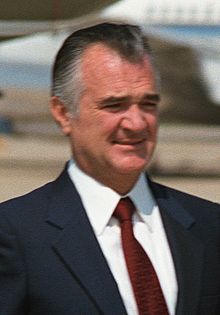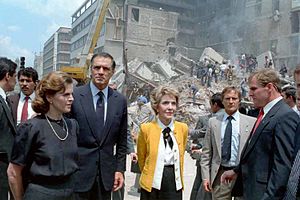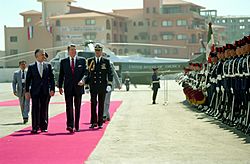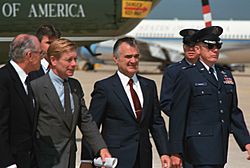Miguel de la Madrid facts for kids
Quick facts for kids
Miguel de la Madrid
|
|
|---|---|

De la Madrid in 1986
|
|
| 59th President of Mexico | |
| In office 1 December 1982 – 30 November 1988 |
|
| Preceded by | José López Portillo |
| Succeeded by | Carlos Salinas de Gortari |
| Director of the Fund of Economic Culture | |
| In office 15 January 1990 – 13 December 2000 |
|
| Preceded by | Enrique González Pedrero |
| Succeeded by | Gonzalo Celorio |
| Secretary of Programming and the Budget of Mexico | |
| In office 16 May 1979 – 30 September 1981 |
|
| President | José López Portillo |
| Preceded by | Ricardo García Sainz |
| Succeeded by | Ramón Aguirre Velázquez |
| Deputy Secretary of Finance and Public Credit of Mexico | |
| In office 29 September 1975 – 16 May 1979 |
|
| President | Luis Echeverría Álvarez (1975–76) José López Portillo (1976–79) |
| Secretary | Mario Ramón Beteta (1975–76) Julio Rodolfo Moctezuma (1976–77) David Ibarra Muñoz (1976–79) |
| Preceded by | Mario Ramón Beteta |
| Succeeded by | Jesús Silva-Herzog Flores |
| Personal details | |
| Born |
Miguel de la Madrid Hurtado
12 December 1934 Colima, Mexico |
| Died | 1 April 2012 (aged 77) Mexico City, Mexico |
| Resting place | Iglesia de Santo Tomás |
| Political party | Institutional Revolutionary Party |
| Spouse | |
| Children | 5 including Enrique |
| Alma mater | National Autonomous University of Mexico (LLB) Harvard University (MPA) |
Miguel de la Madrid Hurtado (Spanish pronunciation: [miˈɣel de la maˈðɾið uɾˈtaðo]; 12 December 1934 – 1 April 2012) was a Mexican politician affiliated with the Institutional Revolutionary Party (PRI) who served as the 59th president of Mexico from 1982 to 1988.
Inheriting a severe economic and financial crisis from his predecessor José López Portillo as a result of the international drop in oil prices and a crippling external debt on which Mexico had defaulted months before he took office, De la Madrid introduced sweeping neoliberal policies to overcome the crisis, beginning an era of market-oriented presidents in Mexico, along with austerity measures involving deep cuts in public spending. In spite of these reforms, De la Madrid's administration continued to be plagued by negative economic growth and inflation for the rest of his term, while the social effects of the austerity measures were particularly harsh on the lower and middle classes, with real wages falling to half of what they were in 1978 and with a sharp rise in unemployment and in the informal economy by the end of his term.
De la Madrid's administration was also famous for his "Moral Renovation" campaign, whose purported goal was to fight the government corruption that had become widespread under previous administrations, which included the arrests of top officials of the López Portillo administration.
In addition, his administration was criticized for its slow response to the 1985 Mexico City earthquake, and the handling of the controversial 1988 elections in which the PRI candidate Carlos Salinas de Gortari was declared winner, amid accusations of electoral fraud.
Contents
Early life and education
Miguel de la Madrid was born in the city of Colima, Colima, Mexico. He was the son of Miguel de la Madrid Castro, a notable lawyer (who was assassinated when his son was only two), and Alicia Hurtado Oldenbourg. His grandfather was Enrique Octavio de la Madrid, the governor of Colima.
He graduated with a bachelor's degree in law from the National Autonomous University of Mexico (UNAM) and received a master's degree in Public Administration from the John F. Kennedy School of Government at Harvard University, in the United States.
In 1953, he was introduced to Paloma Cordero by her older brother. The couple began dating in 1955 and married four years later at the Santa Rosa de Lima Church in Cuauhtémoc in 1959. Cordera and de la Madrid had five children - Margarita, Miguel, Enrique Octavio, Federico Luis and Gerardo Antonio.
Early career
He worked for the Bank of Mexico and lectured in law at UNAM before he got a position at the Secretariat of Finance in 1965. Between 1970 and 1972, he was employed by Petróleos Mexicanos, Mexico's state-owned petroleum company, after which he held several other bureaucratic posts in the government of Luis Echeverría. In 1979, he was chosen to serve in José López Portillo's cabinet as Secretary of Budget and Planning, replacing Ricardo García Sainz.
1982 Election
- Further information: 1982 Mexican general election
De la Madrid had no political experience as an elected official prior to becoming the candidate for the PRI. In the assessment of political scientist Jorge G. Castañeda, López Portillo designated De la Madrid as a candidate by elimination, not by choice, and that De la Madrid remained in contention as a candidate because he was never the bearer of bad news to the president. Other contenders were Javier García Paniagua and David Ibarra Muñoz. When his candidacy was revealed, his "candidacy was greeted with unusual hostility from some sectors of the political establishment--an indication of the emerging rift between the old políticos and emerging technocrats." De la Madrid did not run against a strong opposition candidate. His campaign rhetoric emphasized traditional liberal values of representation, federalism, strengthening of the legislature and the judiciary. There was massive turnout in the election, for the first time in many years, voting overwhelmingly for De la Madrid.
Presidency
De la Madrid inherited the financial catastrophe from his predecessor; Mexico experienced per capita negative growth for his entire term. De la Madrid's handling of the devastating 1985 Mexico City earthquake was his own major misstep. The end of his administration was even worse, with his choice of Carlos Salinas de Gortari as his successor, the split in the PRI with the exit of Cuauhtémoc Cárdenas, and the government's handling of balloting with election results deemed fraudulent. His administration did have some bright spots, with Mexico's becoming a member of the General Agreement on Tariffs and Trade (GATT) in 1985. Mexico also was part of the Contadora process to find a solution of the conflicts in Central America.
Economic policy

Unlike previous Mexican leaders, he was a market-oriented president. Inflation increased on an average of 100% a year and reached to an unprecedented level of 159% in 1987. The underemployment rate soared to 25% during the mid-1980s, income declined, and economic growth was erratic since prices rose usually much faster than incomes.
All that was a stark reminder of the gross mismanagement and policies of his two immediate predecessors, particularly the financing of development with excessive overseas borrowing, which was often countered by high internal capital flights. De la Madrid himself had been Minister of Budget and Programming under López Portillo, and as such he was perceived by many as being co-responsible for the crisis that he himself had to deal with upon taking office. As an immediate reaction to the economic crisis, he first presented the Immediate Economic Reorganization Program (Programa Inmediato de Reordenación Económica) and, a couple of months later, the National Development Plan (Plan Nacional de Desarrollo). Some of the measures proposed were a reduction of public spending, fiscal reforms, a restructuring of the bureaucracy, and employment protection.
During his presidency, De la Madrid introduced neoliberal economic reforms that encouraged foreign investment, widespread privatization of state-run industries, and reduction of tariffs, a process that continued under his successors, and which immediately caught the attention of the International Monetary Fund (IMF) and other international observers. In January 1986, Mexico entered the General Agreement on Tariffs and Trade (GATT) following its efforts at reforming and decentralizing its economy. The number of state-owned industries went down from approximately 1,155 in 1982 to 412 in 1988. De la Madrid re-privatized companies that had been made state-run under his predecessors. He sought better public-private sector relations, but the private sector began backing opposition candidates nonetheless. Given the dire economic circumstances he inherited from his predecessor, he pursued policies of economic austerity, rather than deficit spending.
Domestic elections
President De la Madrid initially stated that further democratization of the country was necessary, and the political system opened up to greater competition. As other parties showed the potential for their electoral success, however, his attitude later seemed to be hostile to the advance of opposition parties, instead allowing the PRI to maintain near-absolute power of the country (at the time, the PRI still governed all of the Mexican states plus the Federal District, in addition to holding 299 of the 400 seats in the Chamber of Deputies and 63 of the 64 seats in the Senate). However, it was during his administration that the opposition National Action Party (also known as "PAN" for its initials in Spanish) started to become popular with the masses, especially in Northern Mexico.
In 1983, during the municipal elections in the northern state of Chihuahua, the PAN won the state's nine biggest Municipalities, which held 70% of its population. The border state had been one of the most affected by the government's policies, specially the nationalization of the Bank decreed in the last months of former President López Portillo's administration. Rather than accepting that the unpopularity and corruption of the PRI in Chihuahua had led to such a defeat, the local PRI bosses claimed that the Catholic Church, the local businessmen and even "foreign influences" had persuaded voters to support the PAN. Most importantly, the local PRI stated that the electoral defeat was a "tragic disaster" that should never be repeated.
The 1986 gubernatorial elections in that same state [es] were marked by accusations of Electoral fraud. Although the PRI candidate, Fernando Baeza, was officially pronounced winner, the PAN candidate Francisco Barrio Terrazas, who officially ended in second place with 35.16% of the vote (at the time, the biggest percentage of votes that an opposition candidate had earned in Chihuahua) did not recognize the results, and the PAN promoted acts of civil disobedience to resist the alleged fraud. Many other local elections were marked by accusations of fraud in those years, sometimes ending with violent clashes. In some small municipalities of Veracruz and Oaxaca, the local population even seized or burned the local Town halls in response to alleged electoral frauds.
Electoral reform
In response to these controversies, an electoral reform was conducted in 1986:
- The number of members of the Chamber of Deputies being elected by proportional representation (plurinominales) was increased from 100 to 200 and allowed for a better representation of opposition parties.
- The Senate is composed of two senators from each state and two from the Federal District of Mexico. An election of half of its members takes place every three years.
- The Legislative Assembly of the Federal District of Mexico was created.
1984 Molotov cocktail attack
On 1 May 1984, an anti-government activist named José Antonio Palacios Marquina, along with others, threw Molotov cocktails at the balcony of the Presidential Palace, where De la Madrid was reviewing the May Day parade. Although the President was unharmed, the incident left many officials and guests injured, including the then-director of the ISSTE, Alejandro Carrillo.
San Juanico explosions
On 19 November 1984, a massive series of explosions occurred at a liquid petroleum gas (LPG) tank farm in the town of San Juan Ixhuatepec (outside of Mexico City, Mexico). The disaster was initiated by a gas leak on the site, likely caused by a pipe rupture during transfer operations, which caused a plume of LPG to concentrate at ground level for 10 minutes. The plume eventually grew large enough to drift on the wind towards the west end of the site, where the facility's waste-gas flare pit was located. The explosions devastated the town of San Juan Ixhuatepec, and resulted in 500-600 deaths and 7,000 people with severe injuries.
The tragedy sparked a national outrage, and President De la Madrid visited the affected area on 20 November. He instructed the creation of a commission to help the survivors and to rebuild the destroyed homes. On 22 December, the Procuraduría General de Justicia found the state-run oil company Pemex to be responsible for the incident, and was ordered to pay indemnification to the victims. Due to the tragedy apparently having been caused by corruption and incompetence at the state-run company, the public further resented the Government and public institutions.
1985 Earthquake

In the morning of 19 September 1985, an 8.0 magnitude earthquake devastated Mexico City and caused the deaths of at least 5,000 people. De La Madrid's mishandling of the disaster damaged his popularity because of his initial refusal of international aid. It placed Mexico's delicate path to economic recovery in an even more precarious situation, as the destruction extended to other parts of the country.
The federal government's first public response was President de la Madrid's declaration of a period of mourning for three days starting from 20 September 1985.
De la Madrid initially refused to send the military to assist on the rescue efforts, and it was later deployed to patrol streets only to prevent looting after a curfew was imposed.
The earthquake created many political difficulties for the then-ruling Partido Revolucionario Institucional (PRI) or Institutional Revolutionary Party. The crisis was severe enough to have tested the capabilities of wealthier countries, but the government from local PRI bosses to President de la Madrid himself exacerbated the problem aside from the lack of money. The Ministry of Foreign Affairs declared it would not request aid.
It was also widely reported in the days after the earthquake that the military assisted factory owners in retrieving their machinery rather than in removing the bodies of dead factory workers.
President de la Madrid was also criticized for refusing to cut foreign debt payments to use the money to help with the recovery effort (at the time, his administration destined around 30% of the federal budget towards the payments of the foreign debt). The government's response to the earthquake was widely criticized at various levels of Mexican society, being seen as both authoritarian and incompetent. As most of the collapsed buildings were of recent construction and public works projects, the government was seen at fault due to mismanagement and corruption in these constructions. The government itself realized that it could not handle the crisis alone through already-established institutions and decided to open the process up to "opposition groups".
1986 FIFA World Cup
During his administration, Mexico hosted the 1986 FIFA World Cup. There were some protests against the tournament, as Mexico was going through an economic crisis at the time and the country was still recovering from the 1985 earthquake, therefore the World Cup was considered by many as a lavish and unnecessary expense. During the World Cup's inauguration at the Estadio Azteca on 31 May, De la Madrid was jeered by a crowd of 100,000 while trying to give a speech, apparently in protest over his administration's poor reaction to the 1985 earthquake.
Split in the PRI
In October 1986, a group of politicians from the Institutional Revolutionary Party (PRI) led by Cuauhtémoc Cárdenas, Porfirio Muñoz Ledo and Ifigenia Martínez, announced the creation of the Democratic Current (Corriente Democrática) within the PRI. The Democratic Current demanded the establishment of clear rules for the selection of the party's presidential candidate. When they failed, Cárdenas, Muñoz Ledo and Martínez left the PRI the following year and created the National Democratic Front (Frente Democrático Nacional), a loose alliance of left-wing parties.
Foreign policy
In 1983, the Contadora Group was launched by Colombia, Panama, Venezuela and Mexico to promote peace in Latin America and to deal with the armed conflicts in El Salvador, Nicaragua, and Guatemala.
1988 election
For the first time since the PRI took power in 1929, the elections featured two strong opposition candidates with enough popularity to beat the PRI candidate.
On Election Day 1988, the computer system used to count the votes shut down, as Cárdenas held an initial lead. That event is remembered by the phrase se cayó el sistema ("the system crashed"). When the system was restored, Carlos Salinas was declared the winner. The expression "se cayó el sistema" became a euphemism for electoral fraud. All the opposition candidates refused to recognize the official results and claimed that a massive electoral fraud had been orchestrated by the government. Nevertheless, Salinas was confirmed by the Chamber of Deputies, controlled by the PRI, as the winner.
Post-presidency
Director of Fondo de Cultura Económica
After completing his term, he became the director of the Fondo de Cultura Económica (FCE) in 1990. He implanted modernization programs in production and administration. It incorporated the most advanced techniques in book publishing and graphic arts and maintained the openness and plurality features in the publication policy of the company.
On 4 September 1992, he inaugurated the new facilities, on 227 Picacho-Ajusco Road. Surrounded by garden and offices, it hosts cultural unity Jesús Silva Herzog, the Gonzalo Robles Library, which houses the growing publishing history of the Fund, and the seller Alfonso Reyes.
On the international scene in 1990, the existing facilities were remodeled subsidiaries. The presence of the Economic Culture Fund acquired a larger projection in the Americas: on 7 September 1990, the subsidiary in San Diego, California, was founded. On 21 June 1991 Seller Azteca opened its doors in São Paulo, Brazil. In 1994 FCE facilities were inaugurated in Venezuela, and in 1998, another subsidiary was established in Guatemala. This Thus, the FCE reached a significant presence in Latin America with nine subsidiaries: Argentina, Brazil, Colombia, Chile, Spain, United States, Guatemala, Peru and Venezuela.
In publishing field, under his direction, 21 new collections were launched: in 1990, Keys (Argentina) in 1991, A la Orilla del Viento, Mexican Codices, University Science and Special Editions of At the Edge of the wind; in 1992, Breviary of Contemporary Science (Argentina) and New Economic Culture, in 1993 Library Prospective, Mexican Library, Library Cervantes Prize (Spain), and History of the Americas Trust and Cruises, in 1994, Word of Life and Indians A Vision of America and the Modernization of Mexico; Files, Sunstone (Peru), Entre Voces, Reading and Designated Fund 2000; Encounters (Peru) History of Mexico, and five periodicals: Galeras Fund, Periolibros, Images, Spaces for Reading and the Fund page.
During his administration, the FCE received several awards, among them: in 1992, FILIJ Book Award (CNCA) to children's books, in 1993 Golden Laurel Award (Department of Culture of the City of Madrid) in 1993, honorable mention Juan García Bacca (Peruvian Cultural Association) Award, and Gold Aztec Calendar (Mexican Association of Radio and Television). In 1994 and 1995 Award Book Bank of Venezuela for children's books.
The Spanish Council for Latin American Studies, distinguished him for his contributions to the development of reading in the Spanish language, received in 1997 the IUS Award by the Faculty of Law of the UNAM, and in 1998 the government of France awarded him the Academic Palms in rank of Commander for his contribution to cultural development. In 1999, Mr. De la Madrid received the medal Picasso Gold (UNESCO), for their work on the diffusion of Latin American culture.
Death
De la Madrid died on 1 April 2012, at 7:30 am in a Mexican hospital apparently following a lengthy hospitalization for complicated chronic obstructive pulmonary disease, which led to acute kidney injury and cardiac arrest.
Public image and legacy
Unlike his predecessors (specially Luis Echeverría and José López Portillo), President De la Madrid was noted for making relatively few speeches and keeping a more reserved and moderate public image. Although that has been attributed to a strategy to break with his predecessors' populist legacies, President De la Madrid's public image was considered "gray". This perception worsened with his government's slow response to the 1985 Earthquake, when President De la Madrid also rejected International aid in the immediate aftermath of the tragedy.
President De la Madrid's biggest legacy may have been his implementation of economic neoliberal reforms in Mexico, breaking with decades of economic nationalism, and beginning mass privatization of state-run companies, a process which would be further deepened during the administration of his successor, Carlos Salinas de Gortari. De la Madrid was also the first of the so-called Technocrats to become president. On the other hand, those reforms and his unwillingness to allow a primary election to choose the PRI candidate for the 1988 Presidential elections are credited as the factors which led to the split of the party in 1987, with Cuauhtémoc Cárdenas and Porfirio Muñoz Ledo founding the Party of the Democratic Revolution (PRD by its initials in Spanish) in 1989, taking a great number of former priístas with them.
Under his "Moral Renovation" campaign, his administration attempted to fight corruption at all Government levels, fulfilling Mexico's foreign debt compromises, and creating the Secretaría de la Contraloría General de la Federación (Secretariat of the General Inspectorate of the Federation) to guarantee fiscal discipline and to keep an eye on possible corrupt officials. Nevertheless, his administration still had some corruption scandals of its own.
Finally, his administration's handling of the 1986 elections in Chihuahua and, specially, the 1988 Presidential elections, remains highly controversial.
In a national survey conducted in 2012, 36% of the respondents considered that the De la Madrid administration was "very good" or "good", 26% responded that it was an "average" administration, and 30% responded that it was a "very bad" or "bad" administration.
See also
 In Spanish: Miguel de la Madrid para niños
In Spanish: Miguel de la Madrid para niños




